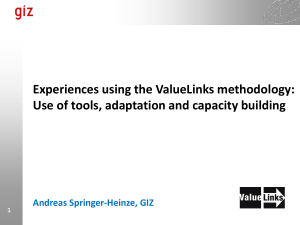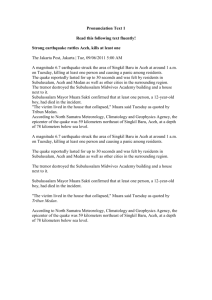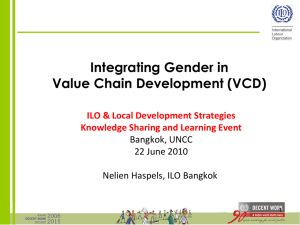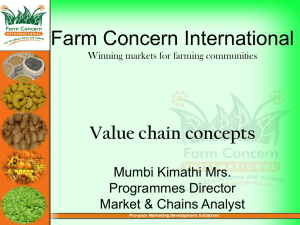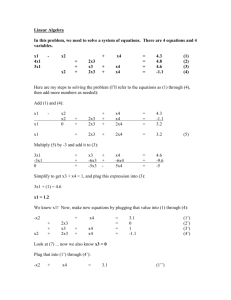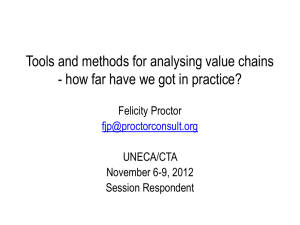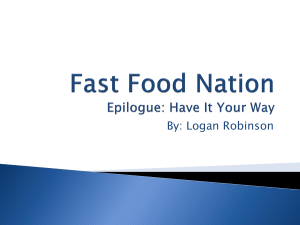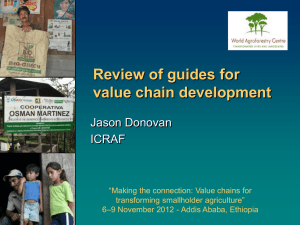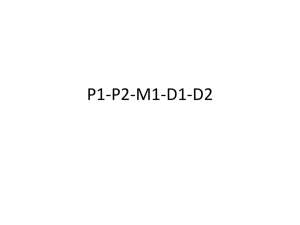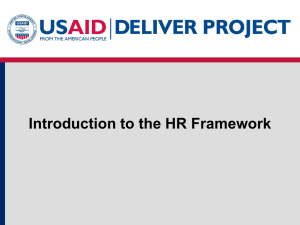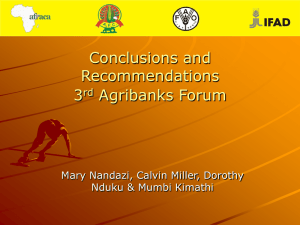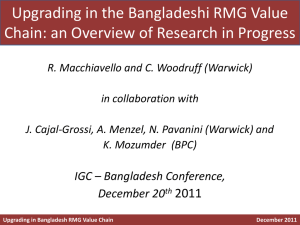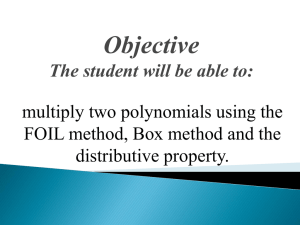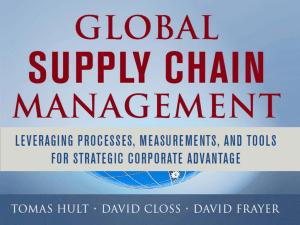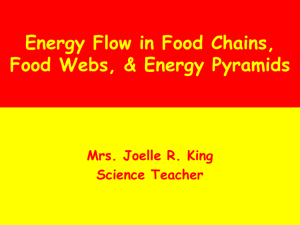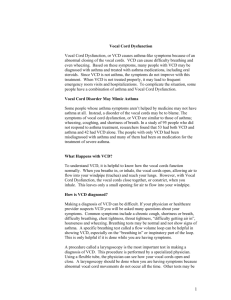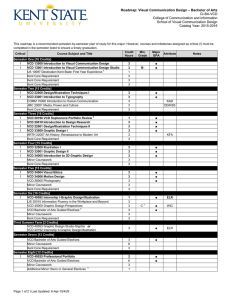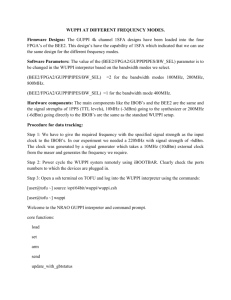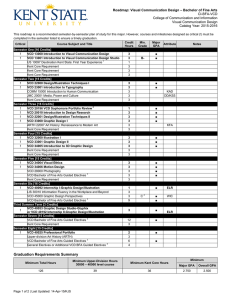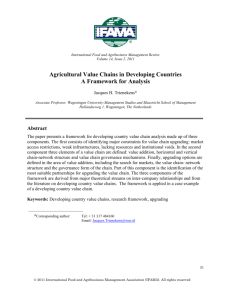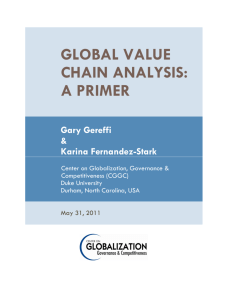The Market System
advertisement
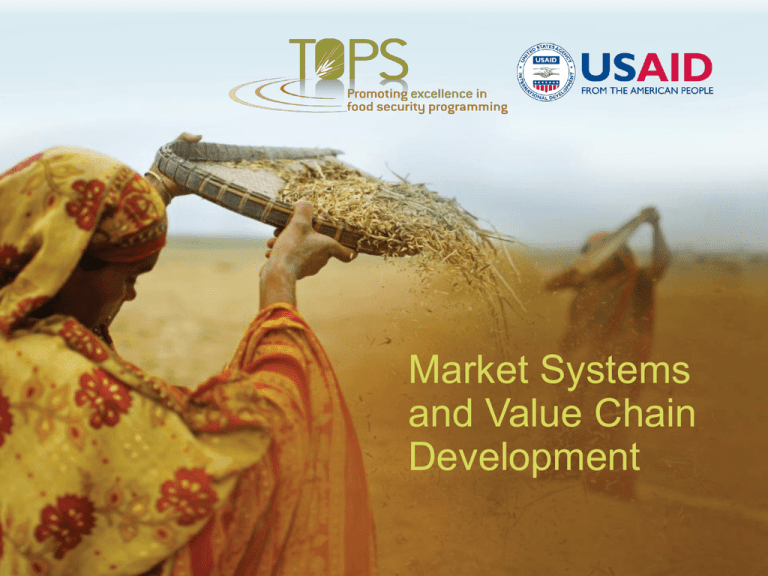
Market Systems and Value Chain Development Introduction to value chains and market systems Value chain development: process and targeting the poor Sharing experiences: good practices, challenges and actions Why are we interested in value chain approaches? The value chain approach can be a powerful tool to create wealth in poor communities and to promote equitable economic growth Why are we interested in market systems? Value chains exist within market systems VC Value Chain (VC) Full range of activities required to bring a product or service from the start, through different phases of production, delivery to final consumers, and final disposal after use Full range of activities required to bring a product or service from the start, through different phases of production, delivery to final consumers, and final disposal after use Bag of chickpeas Carton of milk T-shirt Education Full range of activities required to bring a product or service from the start, through different phases of production, delivery to final consumers, and final disposal after use Narrow sense = activities within a firm/business Broad sense = activities implemented by various actors Global Retailers National Retailers Exporters Wholesalers Processors/Traders Producers Input Suppliers Group work: example of a value chains A value chain exists when all the actors in the chain operate in a way that maximizes the generation of value along the chain Value is added to the preliminary product The value of the product increases as it passes through several stages of the value chain Value = combination of other resources e.g. tools, manpower, knowledge and skills, other raw materials or preliminary products Source: Herr, M.L. and Muzira, T.J. (2009). Value chain development for decent work. ILO Group work: identify costs and add value to your value chain Supply Core Demand Function R&D Coordination Infrastructure Supply SUPPORTING FUNCTIONS Information Informing & communicating Skills & capacities Related Services Core Demand Function R&D SUPPORTING FUNCTIONS Coordination Infrastructure Supply Informal rules & norms Information Informing & communicating Skills & capacities Related Services Core Demand Function Setting & enforcing rules Non-statutory regulations RULES Laws Sector-specific regulations & standards The Market System Government R&D SUPPORTING FUNCTIONS Coordination Infrastructure MARKET ACTORS Delivering & resourcing different functions Supply Informal rules & norms Informal networks Information Private sector Skills & capacities Informing & communicating Related Services Business member organisations Core Demand Function Setting & enforcing rules Non-statutory regulations RULES Laws Sector-specific regulations & standards Work/employee member organisations Not-for-profit sector Source: Springfield Centre Group work: using your example of a value chain, build and example market system around that chain VCD Value Chain Development (VCD) Making the consumer/ customer at the end of the value chain happy Stakeholders along a particular value chain need to cooperate and coordinate their activities VCD is a market-orientated approach 5 key drivers of change that could prompt VCD 1. System Efficiency Reduce costs and increase efficiencies 2. Product Quality Increase the quality of products 3. Product differentiation Competitive advantage – continuous innovation and learning 4. Social & Environmental Standards Improve social standards and minimize environmental impact 5. Enabling Business Environment Working to support not hinder value chain activities 1. 2. 3. 4. 5. System Efficiency Product Quality Product differentiation Social & environmental standards Enabling business environment How do we do VCD programming? 1. Sector Selection Sector? Economic sectors: agriculture, industry and services Narrower definition (subsectors) = tea, dairy, embroidery Within a sector we often find several value chains How do we select a sector? Selecting sectors • • • • Define objectives and target groups Decide on selection criteria Rapid assessment of available sectors Application of selection criteria in consultative meeting with stakeholders Application of selection criteria Criteria Proposed subsector Rice Dairy Handicrafts Unmet market demand 3 1 2 Potential to increase rural incomes 2 1 2 Potential for employment generation 2 2 1 Government or donor interest/existing support for programs 3 2 1 10 6 6 Total weighted score Rank 1 = low, 3 = high Application of selection criteria Criteria Proposed subsector Rice Dairy Handicrafts Unmet market demand (x2) 3x2 = 6 1x2 = 2 2x2 = 4 Potential to increase rural incomes (x3) 2x3 = 6 1x3 = 3 2x3=6 Potential for employment generation (x3) 2x3=6 2x3=6 1x3=3 Government or donor interest/existing support for programs (x1) 3x3=9 2x3=6 1x3=3 27 17 16 Total weighted score Rank 1 = low, 3 = high Not always necessary – may be pre-defined 2. Research, Analysis and Mapping Sector research Value chain analysis (VCA) and research Value chain mapping Primary research and stakeholder analysis & initial value chain map Cross-cutting issues – gender, environment Value Chain Analysis (VCA) or research Refine the value chain map Wholesalers & Distributers Large-scale processors Medan retail/ restaurants By-product traders Medan high-end consumers Medan Kiosks Medan lowend consumers Biscuit & animal feed processors Biscuit consumers & animals N. Aceh retail/ restaurants N. Aceh high-end consumers N. Aceh Kiosks N. Aceh low-end consumers Large Traders By-product processors By-product traders Village collectors Sectorspecific providers Cross-cutting providers including financial Government (BULOG) Sml/med scale processors (Local RMUs, storing, drying, milling, finance) HH consumption BULOG Irrigated rice farmers Rainfed rice farmers Input Suppliers (seeds, tools, fertilisers etc) Local enabling environment Regional enabling environment National enabling environment Limited local soybean supply Dependence on soybean imports High price of cooking oil preparati on food Input supply Waste water management problem Application of good health practices (street vendors) Use of liquid waste for biogas Cleaner production knowledge Linkages with larger input suppliers Improving access to finance (links to MFIs, financial literacy ) Inefficient production methods Linking with formal markets Marketing information on healthy aspects of tofu Consumpti on Retailing Use of formaldehyde & borax Processin g Use plastics in frying tofu to add crunch – health issues (street vendors) Opportunities Used cooking oil stoves (street vendors) Tofu Use of recycled oil in frying (street vendors) Low shelf life Lack of financial access Limited advocacy for tofu producers associated with good health practices Constraints 3. Finding upgrading solutions Upgrading? Acquiring technological capabilities and market linkages to increase competiveness and move to highvalue activities Types of possible upgrading – with a focus on the poor 1. Process upgrading: efficiency of production 2. Product upgrading: introduction of new products or improving old products 3. Functional upgrading: changing to a higher value-added level in the value chain Look at the effect of the upgrade on the whole chain Determine the most effective level to upgrade Questions to consider when targeting the poor Who are the local innovators? What are the mechanisms present in the community to share, maintain and collectively develop skills and knowledge? Can the poor afford it? Can the poor copy it? What will be the impact of the poor as…. Producers Labourers Consumers VCD Project Cycle Source: Herr, M.L. and Muzira, T.J. (2009). Value chain development for decent work. ILO • The VC approach can be a powerful tool to create wealth in poor communities and to promote equitable economic growth • Seeing producers as part of value chains, and value chains as part of market systems, offers the opportunity for systemic change rather than traditional subsidization approach Promising practices, challenges and ideas to improve those challenges (TOPS and others) This presentation was made possible by the generous support of the American people through the United States Agency for International Development (USAID) Office of Food for Peace. The contents are the responsibility of Save the Children and do not necessarily reflect the views of USAID or the United States Government. Today’s sessions • What was great • What was not so great • Recommendations for tomorrow or next time
